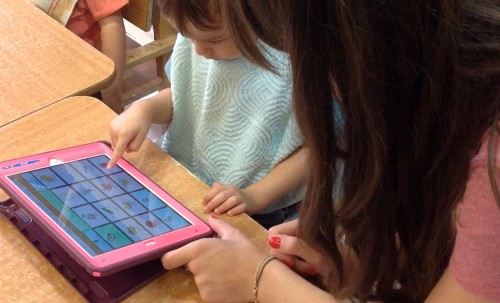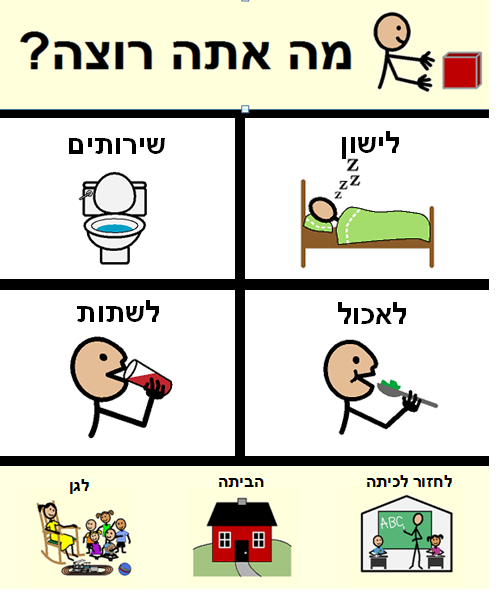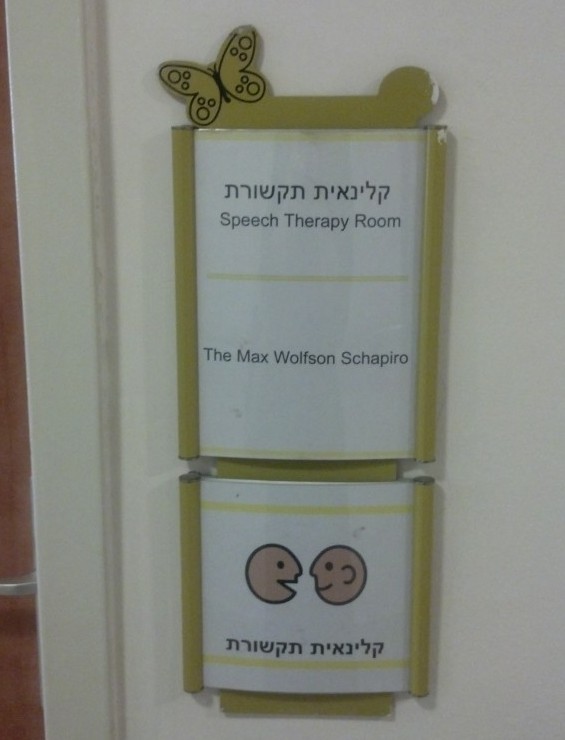For many years at Beit Issie Shapiro, a large organization that provides many services including early intervention and school based programs for children with special needs, we used Boardmaker symbols to create communication boards, both for low and high tech devices. We used the symbols on personal devices, in educational materials and throughout the physical environment. Two years ago, we started the process of an institution-wide transition to SymbolStix. It was a transition we were initially hesitant about and debated thoroughly. It involved a lot of work and preparation and in the end it was carried out in a few stages. Recently, in a workshop we held for local speech therapists, we were asked about the process and why we decided to make the change at all. As a result of that conversation we decided to share our experiences with you, our readers.
We were very happy with the Boardmaker software; we liked both the large library of symbols and their design. The program was easy to use allowing us to make both printed and digital communication boards for personal or group use. We also used the symbols on signs in the environment (hallways, therapy rooms, etc…) to promote exposure and consistency, everywhere and every day.
What prompted the idea that maybe we needed to make a change was the introduction of the iPad and its use in AAC. Many children were starting to bring personal iPads to school already outfitted with AAC apps and each app seemed to have its own unique and often unfamiliar symbol library. Interestingly, not one of these apps used Boardmaker symbols. We suddenly found ourselves in a situation where the symbols used in the classroom and by the staff were different that those used personally by many children, and they were each using symbols different than one another. This lack of consistency and unity between the symbol languages made it very difficult for staff to create communication boards for groups and lessons, and to provide training for support staff and parents. More importantly, we were concerned that this would make it difficult for some children to become familiar with the symbols and acquire language.
As we slowly became exposed with more communication apps, we began to become more familiar with their symbols and were able to evaluate them, in terms of their quality and usefulness. SymbolStix stood out among the other symbol libraries. It has a relatively large symbol library and contains culturally relevant symbols, as well. Many apps have begun to use the SymbolStix library (for example MyTalk, Sono, Avaz, and Pogo) including TouchChat, the app we use and recommend in our programs. Another significant development for us was that the Grid2, an AAC program used on Windows-based communication devices, started to provide SymbolStix symbols as well. For these reasons, we realized that by changing to SymbolStix we could create uniformity of language in our programs ensuring that our children could speak the same language whether they are using an AAC app on an iPad or an AAC program on a Windows based device.
The decision to switch to a different symbol language sparked a lot of doubt amongst the staff and raised more than a few dilemmas. One of the dilemmas concerned the abstractness of the symbols – would they be accessible enough to the children? Another dilemma had to do with those children already using AAC devices that use Boardmaker symbols, especially those of school age that had been using Boardmaker symbols for many years – would they manage the switch to a new symbol set?
The decision was made to make the switch and we began the first phase two years ago, starting with the kindergartens, under the direction of the Speech Therapy Coordinator, Raz Tennenbaum. The team scheduled the switch to coincide with the beginning of a new school year, timing that was meant to make the switch smoother for both children and staff. As we were switching over symbols for the whole program, the demand for new boards and materials was much greater than in the typical school year, and support staff were also trained in use of the program in order to meet our needs. And yet, the demands on the staff to create new communication boards and materials in those first few months were intense, both for the speech therapists and for the teachers.
After success in the kindergartens, we began phase two the next year, switching to SymbolStix in the Special Education School, under the direction of Estelle Slevin, Coordinator of Speech Therapy and of Allied Health Professions. Again the switch required intense preparations and many hours of work on behalf of the speech and education staff. Despite the extra hours of preparation, the school staff were very happy with the change, saying the symbols were more mature than what they were using until now and thus more appropriate for the school-age population.
The last stage of the transition occurred just this past summer in preparation for the current school year, in which all the symbols used throughout Beit Issie Shapiro were changed as well; those that children see in the hallways indicating such things as washrooms, various therapy rooms, the hydrotherapy pool, the snoezelen room, and more.
Now at the end of the process we can say that although switching to a new symbol language required a serious investment of time and effort on our part, we were encouraged to continue and follow through with the complete change because of the children. The transition was relatively smooth and they adapted to the new symbols in a very natural way.
We can never know what the future may bring and what changes may occur with our rapidly changing and evolving technology, but for now this process has allowed us and our children to speak in a uniform language, one that meets our needs.
Following is some information and a few tips that could help you make the transition as well:
In addition to having access to the symbol set through specific communication apps licensed to offer it, n2y, the company that developed SymbolStix, offers an online subscription service to their symbol library. Subscriptions cost $50 per year. Advantages to subscription include the ability to create communication boards online and the ability to download and save symbols as picture files for later use on the iPad or computer. You can access your online account from any device with internet access and can thus create and print materials from anywhere, making the whole process much more flexible. The ability to download files and save them as photos provides the opportunity to incorporate symbols into other materials and not just into communication boards in communication programs. They can be inserted into Power Point, Word, personal stories, and into any app that allows use of personal photos, creating endless opportunities.
For those that do not have a subscription but do currently use and app or program that uses SymbolStix, you too can easily create printed communication boards and materials. Often AAC software includes an option to print boards or pages. For those using AAC apps, you can easily take a screenshot of your communication board and print it for low tech use.
Good luck with the change! We’d love to hear about your experiences. Leave us a note in the comments.






What a wonderful collection of experiences pointing to a successful transition for an entire organization! Congratulations to the organizers, the adopters, and the users. Please reach out if there is anything that n2y and SymbolStix can do for you! There is simply no better way to spend our time than helping others! Nice work!!